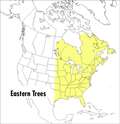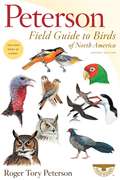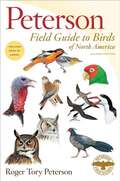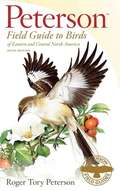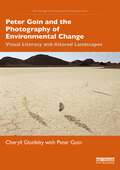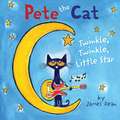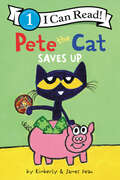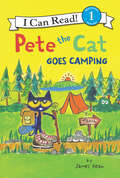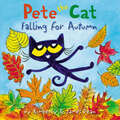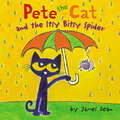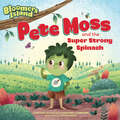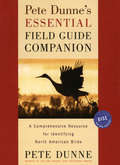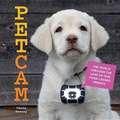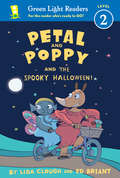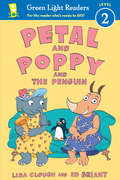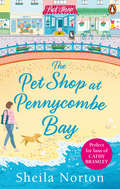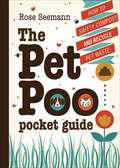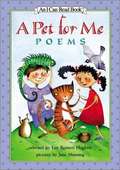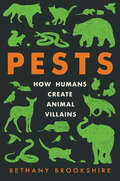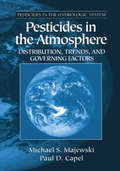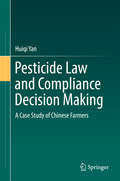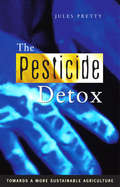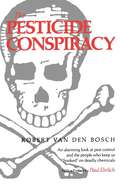- Table View
- List View
A Peterson Field Guide To Eastern Trees: Eastern United States And Canada, Including The Midwest (Peterson Field Guides #Volume 11)
by George A. Petrides Janet WehrFind what you're looking for with Peterson Field Guides—their field-tested visual identification system is designed to help you differentiate thousands of unique species accurately every time. This field guide features detailed descriptions of 455 species of trees native to eastern North America, including the Midwest and the South. The 48 color plates, 11 black-and-white plates, and 26 text drawings show distinctive details needed for identification. Color photographs and 266 color range maps accompany the species descriptions.
Peterson Field Guide to Birds of North America (Peterson Field Guides)
by Roger PetersonIncludes birds of Hawaii. A new edition of the best-selling field guide with 25 all-new plates covering the birds of Hawaii.For decades, the Peterson Field Guide to Birds has been a popular and trusted guide for birders of all levels, thanks to its famous system of identification and unparalleled illustrations. Now that the American Birding Association has expanded its species Checklist to include Hawaii, the Peterson Guide is the first edition to include the wonderful and exotic species of our fiftieth state. In addition, the text and range maps have been updated, and much of the art has been touched up to reflect current knowledge. <P><P><i>Advisory: This book offers only partial accessibility. We have kept it in the collection because it is useful for some of our members. Benetech is actively working on projects to improve accessibility issues such as these in the future.</i>
Peterson Field Guide to Birds of North America (Peterson Field Guides)
by Roger Tory PetersonFor decades, the Peterson Field Guide to Birds has been a popular and trusted guide for birders of all levels, thanks to its famous system of identification and unparalleled illustrations. Since the American Birding Association has expanded its species Checklist to include Hawaii, the Peterson Field Guide now includes the wonderful and exotic species of our fiftieth state. In addition, the text and range maps have been updated, and much of the art has been touched up to reflect current knowledge.
Peterson Field Guide to Birds of Eastern and Central North America
by Roger Tory PetersonWith all-new range maps, updated text, and 40 new paintings, the completely revised editions of two classic Peterson Field Guides are sure to be valuable additions to any birder's pocket or daypack. A team of professional birders has updated the text, the maps, and the art for these authoritative guides. The best-selling field guide since 1934, the Peterson Field Guide to Birds of Eastern and Central North America is now in its sixth edition. With clear, succinct accounts of more than 500 species, accurate and beautiful paintings on 159 color plates, and 512 maps annotated with extensive range information, this is the most up-to-date and accessible field guide for bird watchers in eastern North America.
Peter Goin and the Photography of Environmental Change: Visual Literacy and Altered Landscapes (Routledge Environmental Humanities)
by Peter Goin Cheryll GlotfeltyPeter Goin and the Photography of Environmental Change narrates the forty-year quest of award-winning and internationally exhibited contemporary photographer Peter Goin to document human-altered landscapes across America and beyond. It is a collaborative work between an artist and a literary critic, a retrospective of an accomplished environmental photographer, and an innovative education in visual reading. Enduring howling wind, pounding rain, and blistering sun, Goin bears witness to radioactive landscapes, abandoned mines, simulated swamps, rechanneled rivers, controlled burns, overgrown ruins, industrialized agriculture, shrinking reservoirs, feral spaces in the city, architected wilderness, sacred wastelands, contested borderlands, and more. Based on more than seventy hours of taped interviews with the artist spanning over a decade, trailblazing ecocritic Cheryll Glotfelty narrates the arc of Goin's career, sharing excerpts from their conversations that reveal his brilliant mind and piquant personality while situating his work within the broader context of environmental thinkers. This beautifully illustrated volume, with 200 images in color and black-and-white showcasing Goin’s work, will be a fascinating and insightful read for upper-level students, academics, and researchers in photography, environmental history and culture, landscape studies, and environmental humanities.
Pete the Cat: Twinkle, Twinkle, Little Star (Pete the Cat)
by James Dean Kimberly DeanJoin Pete in New York Times bestselling artist James Dean's Pete the Cat picture book series as he stars in the classic nighttime song "Twinkle, Twinkle, Little Star." Pete the Cat fans new and old will delight as Pete sings about the stars up above in this rendition of a favorite children's bedtime song.
Pete the Cat Saves Up (I Can Read Level 1)
by James Dean Kimberly DeanPete the Cat earns and saves money to buy a supercool toy in this Level 1 I Can Read from New York Times bestselling creators Kimberly and James Dean.Pete the Cat wants a supercool Sharkbot toy, but he doesn’t have enough money in his piggy bank. He takes on odd jobs, from shoveling snow to selling lemonade and more, and saves every penny. How long will it take for him to earn enough money to buy the toy? Find out in this Level 1 I Can Read book complete with original illustrations from the creators of Pete the Cat, Kimberly and James Dean. Pete the Cat Saves Up is perfect for children learning to sound out words and sentences. Whether shared at home or in a classroom, the short sentences, familiar words, and simple concepts of Level One books support success for children eager to start reading on their own.
Pete the Cat Goes Camping (I Can Read Level 1)
by James Dean Kimberly DeanNew York Times bestselling author and artist James Dean takes readers along for an outdoor adventure with Pete the Cat!In Pete the Cat Goes Camping, Pete can't wait to go hiking, fishing, and eat s'mores by the campfire. But when he hears about the mysterious creature named Bigfoot, Pete can't help but wonder: Is Bigfoot real?Kids love exploring the outdoors, and they're sure to enjoy this funny story about Pete the Cat going camping for the first time (and overcoming his small fears).Pete the Cat Goes Camping is a Level One I Can Read book, which means it’s perfect for children learning to sound out words and sentences. Whether shared at home or in a classroom, the short sentences, familiar words, and simple concepts of Level One books support success for children eager to start reading on their own.
Pete the Cat Falling for Autumn (Pete the Cat)
by James Dean Kimberly DeanNew York Times bestselling creators James and Kimberly Dean show us all the wonderful things about autumn. A great book to share with the family at Thanksgiving or anytime!Pete the Cat isn't sure about the changing of the seasons from summer to autumn. But when he discovers corn mazes, hay rides, and apple picking, Pete realizes there's so much to enjoy and be thankful for about autumn.
Pete the Cat and the Itsy Bitsy Spider (Pete the Cat)
by James Dean Kimberly DeanPete the Cat’s cool adaptation of the classic children’s song "Itsy Bitsy Spider" will have have young readers laughing and singing along.The itsy bitsy spider climbed up the water spout. Down came the rain....As the itsy bitsy spider struggles, Pete and his friends know just what to do to help out!Fans of James Dean's #1 New York Times bestselling Pete the Cat will love rocking out with Pete.
Pete Moss and the Super Strong Spinach: Bloomers Island Garden of Stories #1 (Bloomers Island #1)
by Cynthia Wylie Courtney CarboneFollow Pete Moss in this magical, beautifully illustrated story as he attends boarding school on Bloomers Island to learn about gardening and growing his own vegetables. When Professor Sage announces the Very Very Veggie Challenge, Pete immediately knows what he needs to grow spinach. It&’s the one vegetable that can make him stronger. But does Pete have the patience to grow his spinach plants to win the contest? With the help of headmaster Professor Sage and his fellow Bloomers, Pete learns all about spinach, working hard toward his goals, and that good things take time to happen!The Bloomers Isalnd series brings to life the world of gardening and healthy-eating to young children in new and exciting ways.
Pete Dunne's Essential Field Guide Companion: A Comprehensive Resource for Identifying North American Birds
by Pete DunneFrom the award-winning birder and author of Birds of Prey, an authoritative, information-packed guide to distinguishing North American birds.In this book, bursting with more information than any field guide could hold, the well-known author and birder Pete Dunne introduces readers to the &“Cape May School of Birding.&” It's an approach to identification that gives equal or more weight to a bird's structure and shape and the observer's overall impression (often called GISS, for General Impression of Size and Shape) than to specific field marks. After determining the most likely possibilities by considering such factors as habitat and season, the birder uses characteristics such as size, shape, color, behavior, flight pattern, and vocalizations to identify a bird. The book provides an arsenal of additional hints and helpful clues to guide a birder when, even after a review of a field guide, the identification still hangs in the balance. This supplement to field guides shares the knowledge and skills that expert birders bring to identification challenges. Birding should be an enjoyable pursuit for beginners and experts alike, and Pete Dunne combines a unique playfulness with the work of identification. Readers will delight in his nicknames for birds, from the Grinning Loon and Clearly the Bathtub Duck to Bronx Petrel and Chicken Garnished with a Slice of Mango and a Dollop of Raspberry Sherbet.
Petcam
by Chris KeeneyAs close as we are to our beloved pets, we often wonder how they spend their days when we aren't watching. What do they explore? How does the world look from the point of view of our dogs and cats--or our chickens and goats? PetCam, by photographer Chris Keeney, author of Pinhole Cameras, presents a collection of striking and amusing images created by an international roster of four-legged photographers. With small, lightweight cameras attached to their collars and cowbells, they document what they see as they go about their daily routines--lounging under parked cars, scaling rooftops, jumping fences, relaxing in a neighbor's tall grass. You'll see the world through the eyes of more than twenty intrepid pets, including Coulee, a Border Collie-Golden Retriever mix from Alberta, Canada; Fritz, a tabby cat living in the Ore Mountains of Germany; Walter and Hamlet, brother and sister miniature pot belly pigs from San Diego; and Sofie, a Galloway cow, who spends her days roaming the hills of the Swiss Alps. This unique and whimsical collection offers a peek into the wanderings of our animal friends, and reveals how they experience the world we all share.
Petal and Poppy and the Spooky Halloween! (Green Light Readers Level 2)
by Ed Briant Lisa CloughHalloween is here and Petal and Poppy are going to a party! But Petal's scared. Halloween is too spooky. But Poppy assures Petal it's all just pretend. There's nothing to be afraid of. But then a haunted house scares Poppy. Maybe Halloween is a little spooky after all! The writing level and picture clues will help early readers perfect their reading technique, while the wonderful story--with just the right amount of spookiness--will spark a love of reading that will last a lifetime.
Petal and Poppy and the Penguin (Green Light Readers Level 2)
by Ed Briant Lisa CloughPetal and Poppy discover an uninvited visitor in their garden—a penguin! At first, Petal's too afraid to let him in. But eventually not even Petal can resist this cute, friendly, and very talented little guy! Petal and Poppy and the Penguin is the second Petal and Poppy book, told in graphic form. Word repetition, picture clues, and a simple plotline facilitate young readers in their development into lifelong lovers of reading.
The Pet Shop at Pennycombe Bay: An uplifting story about community and friendship
by Sheila NortonA heartwarming and uplifting tale of community, friendship and love to curl up with this summer – perfect for fans of Phillipa Ashley, Milly Johnson and Jill Mansell.'A thoroughly enjoyable read' Katie Fforde, Sunday Times bestselling author of A Country EscapeWhen the going gets ruff, it’s time to make a change…In need of a fresh start, Jess has moved to the beautiful Devon seaside town of Pennycombe Bay. However it isn’t the new beginning she was hoping for – she enjoys her new job at the local pet shop but feels like she’s treading on eggshells living with her moody cousin Ruth.When she meets handsome stranger, Nick, on the beach, she thinks she’s made a new friend or something more. Although her hopes of romance are quickly dashed when she finds out he’s seeing another woman…Can Jess make Pennycombe feel like home?Fans of Cathy Bramley, Carole Matthews and Katie Fforde will love Sheila Norton’s charming, wonderfully warm, feel-good books.*You can now pre-order Sheila's new novel, The Lonely Hearts Dog Walkers*
The Pet Poo Pocket Guide: How to Safely Compost and Recycle Pet Waste
by Rose SeemannEighty-three million dogs and ninety-six million cats call the United States home. Dogs alone produce enough waste to fill more than 1,091 football fields 1 foot deep in a single year. Add billions of plastic pick-up bags to the mix and season well with tons of litter box waste. Scoop a hefty portion into local landfills and seal it tightly to ensure optimal methane production. Clearly, this is a recipe for disaster.Dog and cat owners who trash their pets' offerings daily are in denial about how much waste is produced and what happens to it. Those who want to make the responsible choice often turn to the internet, only to find misleading, confusing, and contradictory information. The Pet Poo Pocket Guide will help you reduce your pet's environmental paw print with: Best practices for cycling pet waste back to nature Suggestions on how to tailor your approach based on location, situation, weather, needs, or available time Instructions for using your composted pet waste safely to enrich your soil and nourish ornamental plantsWith recycling tactics clearly indicated as "easy," "moderate," or "demanding," The Pet Poo Pocket Guide offers something for everyone. This no-nonsense guide is a must-read for any pet owner who is concerned about the environmental impact of their best friend, and is seeking a safe and practical solution.Rose Seemann is the owner and operator of EnviroWagg, a company dedicated to collecting and composting canine waste into safe, nutrient-rich garden soil.
Pet Parrots (Nature's Children)
by Frank PuccioWhat can compare with the sight of a large, beautiful bird flying through the air or landing--brightly colored wings stretched out--on a branch? Birds, with their colors and flight, have fascinated people for thousands of years. The ancient Egyptians had gods who were birds. The ancientGreeks told tales of daredevils who tried to add wings and feathers to their bodies. And for hundreds of years inventors of all nations worked to create machines that would allow humans to fly like the birds. Of all the birds of the world few are as colorful and as fascinating as parrots. Beautiful, affectionate, and full of individual personality, they even are clever enough to talk. It's no wonder that for hundreds of years they have been among the world's most treasured pets and companions.
A Pet for Me: Poems (I Can Read! #Level 3)
by Lee Bennett Hopkins Jane ManningFrom a devoted mutt giving "sloppy doggy kisses" to a tarantula munching happily on a cricket lunch, this lively collection of twenty poems celebrates the relationship between children and their pets. Popular poet and noted anthologist Lee Bennett Hopkins brings together many of today's best children's poets -- including X. J. Kennedy, Alice Schertle, and Karla Kuskin -- in this delightful festival of friendship. Jane Manning's bright and richly textured art cheerfully complements these playful poems.
Pests of Landscape Trees and Shrubs (Second Edition)
by Steve H. Dreistadt Jack Kelly Clark Mary Louise FlintThis is the ultimate guide to managing landscape pests! With this manual in hand you will be able to diagnose and manage hundreds of insect, mite, weed, plant disease, and nematode pests. Inside you'll find updated information on how to use environmentally safe, ecologically based IPM methods; landscape designs that prevent pests; how to select resistant varieties; advice on the use of less-toxic pesticides such as botanicals, oils, and soaps; and tips on planting, irrigating, and other plant-care cultural activities that help in avoiding problems. Contains over one hundred pages of easy-to-use tree and shrub pest tables; invaluable in helping you identify common pest problems now on over 200 types of ornamental trees and shrubs. Includes 432 color photographs, 117 drawings and tables, references, glossary, and an index.
Pests: How Humans Create Animal Villains
by Bethany BrookshireAn engrossing and revealing study of why we deem certain animals “pests” and others not—from cats to rats, elephants to pigeons—and what this tells us about our own perceptions, beliefs, and actions, as well as our place in the natural worldA squirrel in the garden. A rat in the wall. A pigeon on the street. Humans have spent so much of our history drawing a hard line between human spaces and wild places. When animals pop up where we don’t expect or want them, we respond with fear, rage, or simple annoyance. It’s no longer an animal. It’s a pest.At the intersection of science, history, and narrative journalism, Pests is not a simple call to look closer at our urban ecosystem. It’s not a natural history of the animals we hate. Instead, this book is about us. It’s about what calling an animal a pest says about people, how we live, and what we want. It’s a story about human nature, and how we categorize the animals in our midst, including bears and coyotes, sparrows and snakes. Pet or pest? In many cases, it’s entirely a question of perspective.Bethany Brookshire’s deeply researched and entirely entertaining book will show readers what there is to venerate in vermin, and help them appreciate how these animals have clawed their way to success as we did everything we could to ensure their failure. In the process, we will learn how the pests that annoy us tell us far more about humanity than they do about the animals themselves.
Pesticides in the Atmosphere: Distribution, Trends, and Governing Factors
by Michael S. MajewskiMost people know about the presence and health effects of pesticide residues in the water they drink. However, they may not realize the impact of atmospheric transportation and deposition of pesticides on water quality. Scientific studies of pesticides in various atmospheric matrices (air, rain, snow, aerosols, and fog) provide some of the answers.
Pesticide Law and Compliance Decision Making
by Huiqi YanThis book investigates pesticide compliance in China in order to provide a more comprehensive understanding of compliance and offers some feasible and adaptable suggestions for enhancing the effectiveness of this compliance. It discusses the weak implementation of Chinese laws and rules and emphasizes the necessity and importance of a compliance perspective in China that focuses on why laws are obeyed or broken. It examines how vegetable farmers' perceptions of amoral calculation affect their pesticide compliance behavior and analyzes how the legitimacy of law is related to compliance to better explain how all the variables interact to shape compliance. It discusses both qualitative and quantitative methods, and uses a large-N qualitative approach, which allows for systematic analysis and in-depth exploration. This book will help readers to understand compliance in developing China by adopting and developing compliance theories which are broadly developed in the West.
The Pesticide Detox: Towards a More Sustainable Agriculture
by Jules PrettySince the 1960s, the world's population has more than doubled and agricultural production per person has increased by a third. Yet this growth in production has masked enormous hidden costs arising from widespread pesticide use - massive ecological damage and high incidences of farmer poisoning and chronic health effects. Whereas once the risks involved with pesticide use were judged to be outweighed by the potential benefits, increasingly the external costs of pesticides, to environments and human health, are being seen as unacceptable. In response to this trend, recent years have seen millions of farmers in communities around the world reduce their use of harmful pesticides and develop cheaper and safer alternatives. The Pesticide Detox explores the potential for the phasing-out of hazardous pesticides and the phasing-in of cost effective alternatives already available on the market. This book makes clear that it is time to start the pesticide detox and to move towards a more sustainable agriculture.
The Pesticide Conspiracy
by Robert Van Den BoschProfessor van den Bosch of the University of California was one of the developers of Integrated Pest Management—the use of biological controls, improved pest knowledge and observation, and judicious application of chemicals only when absolutely necessary. His research often suggested that less or no pesticides should be applied, which made him the target of both open and clandestine attack from industry and government figures. In protest, he wrote this passionate account of what Ecology called "the ultimate social disaster of: evolving pesticide-resistant insects, the destruction of their natural predators and parasites, emergent populations of new insect pests, downstream water pollution, atmospheric pollution, the 'accidental' killing of wildlife and people, and the bankruptcies of indigenous and small farmers."As a new Introduction to this edition recounts, some lessening of dangerous overreliance on massive pesticide applications has been achieved since van den Bosch published this book in 1978—partly as a result of its influence. But the structural problems he described remain. The book has thus become a classic, along with Rachel Carson's Silent Spring.
